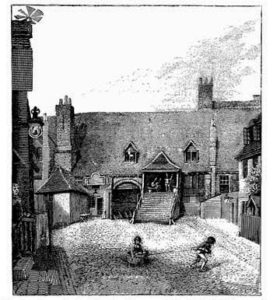This post has kindly been written by Dr. Philip Carter, Head of IHR Digital at the Institute of Historical Research.

The Guardroom, Scotland Yard. From an Etching by J. T. Smith, 1805.
As you may have seen, last week the Metropolitan Police moved into their very smart new residence, between London’s Whitehall and the Embankment. It’s still called New Scotland Yard, and after 50 years at Broadway, near Victoria, the Met has also returned to its former location (also ‘New Scotland Yard’) in a building dating from 1937-40. In doing so, the Service returns close to the site of its original residence, at 4 Whitehall Place, backing on to Great Scotland Yard, where it started out in 1829.
Last week, and by happy coincidence, British History Online also unveiled its latest Scotland Yard venture: a digitized copy of William John Loftie’s Whitehall: Historical and Architectural Notes (1895). An assistant chaplain at the Chapel Royal, Savoy, Loftie pursued an active second career as an antiquary and author. His many publications include Inigo Jones and Wren, or, Rise and Decline of Modern Architecture in England (1893) which, like his Notes, is characterized by forceful opinion on what he considered good, and less good, design. No fan of Gothic revivalism, Loftie (somewhat grumpily, perhaps) gave his recreation in Who’s Who as ‘searching for unrestored churches’.
Loftie’s guide is a relatively short work but it’s richly illustrated with 25 images and plates depicting seventeenth and eighteenth-century Whitehall. Not surprisingly, Inigo Jones’s design for the Banqueting Hall, part of the Palace of Whitehall, features prominently in the collection. But there are also engravings of major events, including the execution of Charles I (1649) and the funeral procession of Mary II (1694), as well as a streetscape from 1724. Two further images depict Scotland Yard at the northern end of the street, close to the Palace of Westminster. One of these images dates from the mid-eighteenth century while the second is from 1805, twenty-four years before the arrival of the Metropolitan Police Service.

Whitehall in 1724.
Whitehall: Historical and Architectural Notes is the first of several illustrated historical works to be added to British History Online in the coming months. Forthcoming titles include the Picturesque Beauties series which depicts the pastoral charms of the early nineteenth century Kent and Essex. Digitization of these volumes is part of a programme to extend further the historical digital images available via BHO—as plates, line drawings, photographs and maps of which there are currently more than 48,000 in the collection.
Loftie’s Notes also adds to BHO’s already extensive coverage of the history and architecture of Whitehall. This includes chapters on Scotland Yard from the Survey of London (vol. 16, 1935) and on the Yard and the early Met from Walter Thornbury’s Old and New London. (Across BHO you’ll find a further 196 historical references to the premises and history of the Metropolitan Police.) Writing in 1878, Thornbury, described the Yard ‘as a poor and mean space, irregularly built, and which certainly is no credit to the city of which it forms so important a part’ (Old and New London: Volume 3, pp329-337). Following its latest £58mn refit, the Met’s newest home is certainly not this.

You can even see the remains of the neo-palladian architecture in these plaques. It’s nice to see that AHMM has honoured some of the original tradition of the building, even if it is just the toilets which are actually coloured according to the old Met patrol car livery!